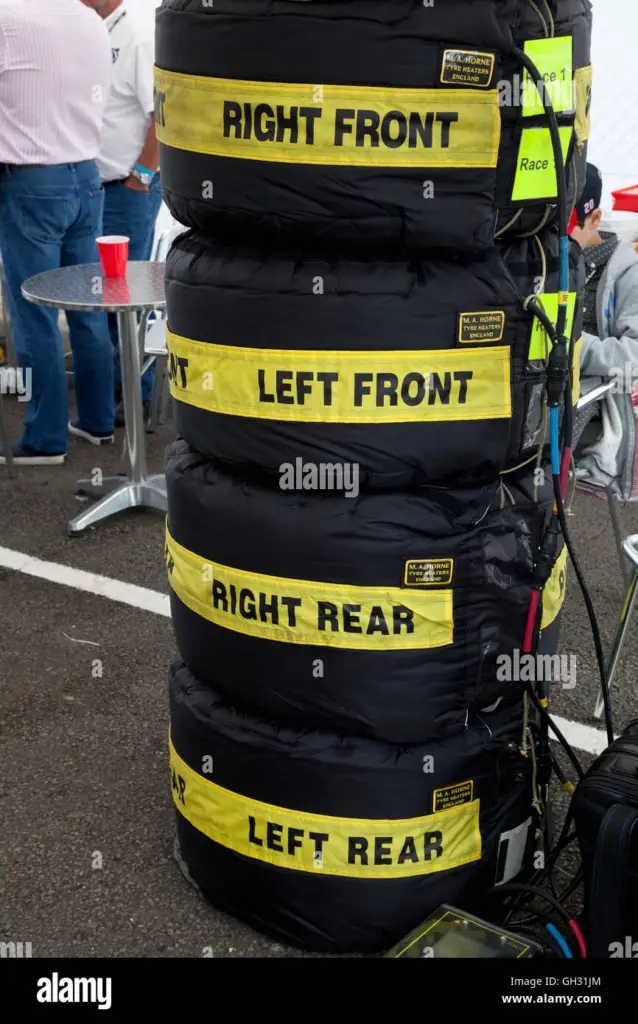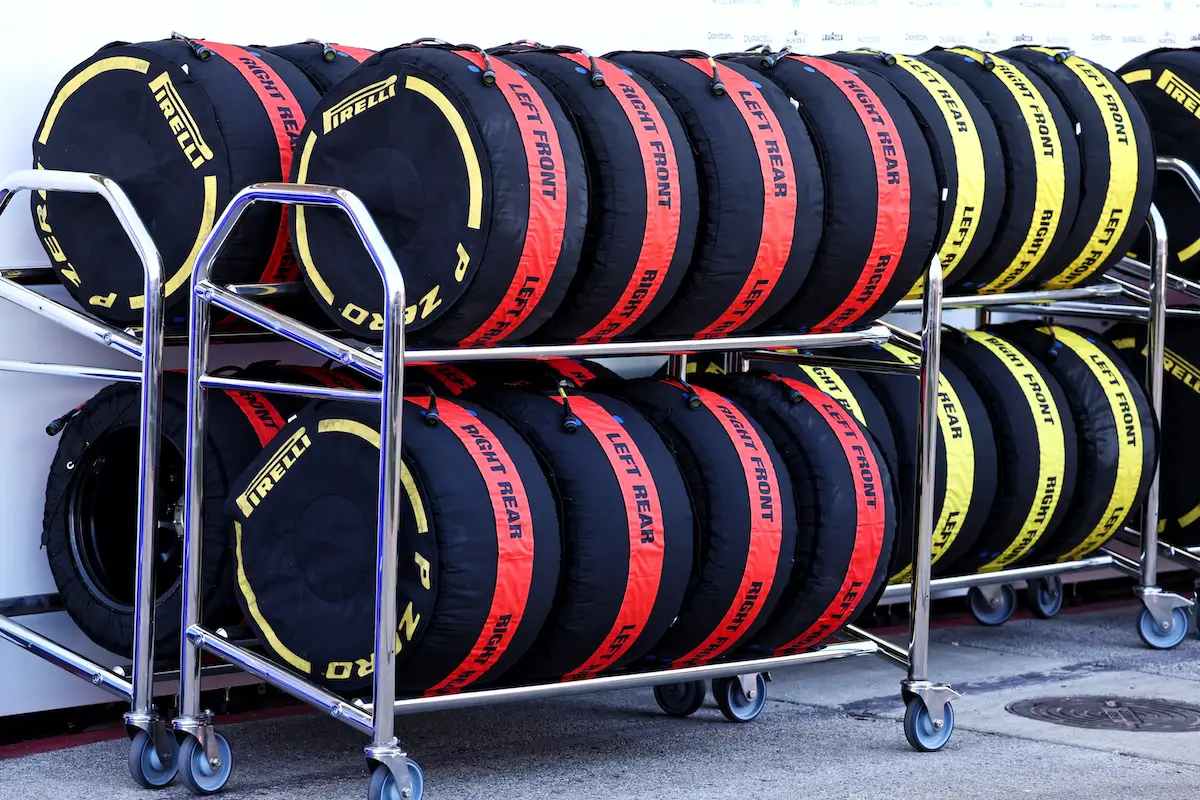Formula 1 racing is synonymous with cutting-edge technology and innovation. It’s a sport where every fraction of a second counts, and the difference between victory and defeat often comes down to the smallest details, even the use of seemingly mundane items like tire blankets.
Tire blankets, as simple as they may seem, have revolutionized the world of Formula 1 racing. These seemingly simple yet highly sophisticated devices have become an integral part of every F1 team’s strategy.
In this article, we will delve into the world of F1 tire blankets, exploring why they are used, how they work, their cost, and what the future holds for this essential piece of equipment.
F1worldwide.com also Recommends the Following Articles
- Understanding F1 Tire Wear: What It Is and How It Affects Races
- Why Do Teams Fill An F1 Tire With Dry Nitrogen Gas?
- How F1 Brakes Work – The Ultimate Guide
Why Are F1 Tire Blankets Used and Why Are They Needed?
The rubber that meets the road is one of the most critical aspects of a Formula 1 car’s performance. Tires are responsible for providing the grip for cornering and acceleration.
They also play a significant role in the car’s overall balance and handling.
To extract the maximum potential from these high-performance racing tires, teams have turned to blankets.

Tire Temperature Management
Tire temperature management is paramount in Formula 1 racing. The tires must operate within a specific temperature range to deliver optimal performance.
The tires grip the track surface best when they are at an ideal temperature, which is typically between 180°C (356°F) and 220°C (428°F).
Below this range, the tires become too hard and lose grip, leading to reduced traction and longer braking distances.
Above this range, they become too soft, causing excessive wear and a decrease in performance.
Cold Tire Phenomenon
Before tire blankets became standard equipment in Formula 1, teams faced a significant challenge known as the “cold tire phenomenon.”
When racing in cold weather conditions or after a pit stop, tires lose a substantial amount of heat, dropping below the optimal operating temperature range.
This cold tire scenario was particularly problematic during restarts after safety car periods or when using fresh tires.
Need for Consistency
Consistency is key in Formula 1. Drivers must be able to trust that their car will handle consistently from one lap to the next.
Without the ability to control the tire temperature in the pit, the tire temperatures could vary widely, making it challenging for drivers to predict how their car would respond.
This inconsistency could lead to loss of control, compromising safety and performance.
How Do the F1 Tire Blankets Work?

They address the challenges of tire temperature management.
They consist of multiple components that work together to heat and maintain the tires at the desired operating temperature.
F1 Tire Blankets have Heating Elements
At the core of the unit are electric heating elements. Engineers install the heating elements inside the blanket’s layers and directly contact the tire’s surface.
Electricity powers them and generates heat rapidly. They quickly heat the tire to the desired range.
F1 Tire Blankets have Insulation
The high-quality insulation materials retains heat effectively. These materials trap the generated heat within the blanket, preventing it from dissipating into the environment.
The insulation helps maintain a consistent temperature across the entire tire surface.
F1 Tire Blankets have Temperature Control

Precise temperature control is crucial for achieving optimal tire performance. The units advanced temperature control systems allow teams to set and maintain the desired tire temperature accurately.
The team’s engineers set the heat control and monitor it in real-time to make adjustments as needed.
Tire Blanket Installation
They are custom-made to fit the specific tire sizes used in Formula 1 racing. They wrap around the tires snugly, ensuring even heat distribution.
When a car enters the pits or before the race starts, tire blankets are placed on the tires, covering them completely.
They activate the heating elements to raise the tire temperatures to the optimal range.
How Much Do the F1 Tire Blankets Cost?
The costs can vary significantly based on the brand, features, and quality. They are highly specialized pieces of equipment.
The prices reflect the cutting-edge technology and engineering that goes into their design.
Typically, one blanket can cost anywhere from $2,000 to $5,000 or even more per set.
Over a weekend the tire blankets may cost a team $27,500 for each car.
Customization and Features

Teams often have the option to customize their tire blankets to meet their specific needs. Customization may include features like temperature control accuracy, insulation materials, and compatibility with different tire sizes.
These additional features can influence the cost of the tire blankets.
Reliability and Performance
In the world of Formula 1, reliability and performance are paramount. Teams are willing to invest in high-quality units that ensure consistent performance on the track.
While cheaper alternatives may be available, they may not provide the same level of control and reliability required in the sport.
Cost-Benefit Analysis
The cost of F1 tire blankets is part of the broader context of the team’s budget. Teams weigh the benefits of using blankets that provide better tire performance, reduced tire wear, and enhanced safety against the upfront cost.
The potential gains on the track often justify the investment in this essential equipment.
What Is the Future Technology of F1 Tire Blankets?
As Formula 1 continues to evolve, so do the technologies that support it. The future of F1 tire blankets holds promise in several key areas:
Advanced Materials

One avenue of development in F1 tire blankets is the exploration of advanced materials. Engineers are researching and testing materials that offer improved insulation properties while being lightweight and durable.
These materials can enhance the blankets’ performance and reduce energy consumption.
Energy Efficiency
In an era focused on sustainability and reducing the carbon footprint of Formula 1, there is a growing interest in making tire blankets more energy-efficient.
This involves developing more efficient heating elements, better insulation, and optimizing temperature control systems to minimize energy consumption without compromising performance.
Integration with Telemetry
The integration of tire blankets with telemetry systems is another exciting development. Telemetry allows teams to gather real-time data from the car, including tire temperature.
In the future, tire blankets may be connected to these systems, enabling even more precise control and monitoring of tire temperatures.
Smart Units
The concept of smart tire blankets is on the horizon. Sensors and AI-driven systems will autonomously adjust tire temperatures based on real-time track conditions and the car’s performance.
Such innovation could provide a competitive edge to Formula 1 teams.
Why is the FIA looking at Banning F1 Tire Blankets
The Federation Internationale de l’Automobile (FIA), the governing body of Formula 1, has been considering a ban on tire-warming blankets. The decision was initially made on sustainability grounds.
The FIA wanted to ban tire blankets to reduce emissions, not just because of the electricity used to heat the tires, but also as a way of reducing carbon emissions through freight.
Are They going to be Banned?
The FIA had set a deadline to hold a vote of teams by the end of July 2023 to decide whether tire blankets would be banned in 2024. However, after a meeting of the F1 Commission, it was confirmed that a ban will not go ahead.
The decision to postpone the ban came after drivers expressed concerns that removing tire blankets was a safety risk. They believe that the lack of grip from unheated tires when they come out of the pits could be a safety factor.
Testing on tires that can generate grip sufficiently quickly from cold will continue and the issue will be reassessed next year. The Formula 1 Commission has voted to postpone the introduction of a tire blanket ban for dry tires in 2024, with further discussion and testing on the subject to continue into 2025.
Conclusion
F1 tire blankets have become an indispensable tool for Formula 1 teams, addressing the critical issue of tire temperature management and consistency. They ensure that tires operate within the optimal temperature range, allowing drivers to push their cars to the limit while maintaining control and safety.
While these tire blankets come at a significant cost, the benefits they bring in terms of performance and safety justify the investment for F1 teams.
Looking ahead, the future of F1 tire blankets is promising, with ongoing research into advanced materials, energy efficiency, telemetry integration, and smart technologies. As Formula 1 continues to push the boundaries of innovation, tire blankets will remain a key component in the quest for victory on the world’s most prestigious racing circuits.

